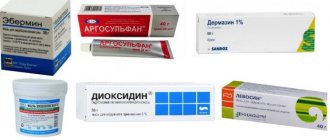Ibuprofen
The simultaneous use of ibuprofen with the following drugs should be avoided:
- Acetylsalicylic acid: with the exception of low doses of acetylsalicylic acid (no more than 75 mg per day) prescribed by a doctor, since combined use may increase the risk of side effects. With simultaneous use, ibuprofen reduces the anti-inflammatory and antiplatelet effect of acetylsalicylic acid (an increase in the incidence of acute coronary insufficiency in patients receiving small doses of acetylsalicylic acid as an antiplatelet agent is possible after starting ibuprofen).
- Other NSAIDs, in particular selective COX-2 inhibitors: simultaneous use of two or more drugs from the NSAID group should be avoided due to a possible increased risk of side effects.
Use with caution simultaneously with the following medications:
- Anticoagulants and thrombolytic drugs: NSAIDs may enhance the effect of anticoagulants, in particular warfarin and thrombolytic drugs.
- Antihypertensive drugs (ACE inhibitors and angiotensin II antagonists) and diuretics: NSAIDs may reduce the effectiveness of drugs in these groups. In some patients with impaired renal function (eg, dehydrated patients or elderly patients with impaired renal function), coadministration of ACE inhibitors or angiotensin II antagonists and cyclooxygenase inhibitors may lead to a deterioration of renal function, including the development of acute renal failure. (usually reversible). These interactions should be considered in patients taking coxibs concomitantly with ACE inhibitors or angiotensin II antagonists. In this regard, the combined use of the above drugs should be prescribed with caution, especially in the elderly. Patients should be prevented from dehydration and consideration should be given to monitoring renal function upon initiation of this combination treatment and periodically thereafter.
Diuretics and ACE inhibitors may increase the nephrotoxicity of NSAIDs.
- Glucocorticosteroids: increased risk of gastrointestinal ulcers and gastrointestinal bleeding.
- Antiplatelet agents and selective serotonin reuptake inhibitors: increased risk of gastrointestinal bleeding.
- Cardiac glycosides: simultaneous administration of NSAIDs and cardiac glycosides can lead to worsening heart failure, a decrease in glomerular filtration rate and an increase in the concentration of cardiac glycosides in the blood plasma.
— Lithium preparations: there is evidence of the likelihood of an increase in the concentration of lithium in the blood plasma during the use of NSAIDs.
- Methotrexate: there is evidence of the likelihood of an increase in the concentration of methotrexate in the blood plasma during the use of NSAIDs.
- Cyclosporine: increased risk of nephrotoxicity with simultaneous administration of NSAIDs and cyclosporine.
- Mifepristone: NSAIDs should be started no earlier than 8-12 days after taking mifepristone, as NSAIDs may reduce the effectiveness of mifepristone.
- Tacrolimus: when NSAIDs and tacrolimus are co-administered, the risk of nephrotoxicity may increase.
— Zidovudine: simultaneous use of NSAIDs and zidovudine may lead to increased hematotoxicity. There is evidence of an increased risk of hemarthrosis and hematomas in HIV-positive patients with hemophilia who received concomitant treatment with zidovudine and ibuprofen.
- Quinolone antibiotics: in patients receiving concomitant treatment with NSAIDs and quinolone antibiotics, the risk of seizures may increase.
— Myelotoxic drugs: increased hematotoxicity.
— Cefamandole, cefoperazone, cefotetan, valproic acid, plicamycin: increased incidence of hypoprothrombinemia.
- Drugs that block tubular secretion: decreased excretion and increased plasma concentrations of ibuprofen.
— Inducers of microsomal oxidation (phenytoin, ethanol, barbiturates, rifampicin, phenylbutazone, tricyclic antidepressants): increased production of hydroxylated active metabolites, increased risk of developing severe intoxications.
Microsomal oxidation inhibitors: reducing the risk of hepatotoxicity.
— Oral hypoglycemic drugs and insulin, sulfonylurea derivatives: increased effect of drugs.
- Antacids and cholestyramine: decreased absorption.
— Uricosuric drugs: decreased effectiveness of drugs.
— Caffeine: increased analgesic effect.
The use of ibuprofen in gynecological practice
Probably, almost every woman at least once in her life has encountered such a condition as painful menstruation. For some, pain during menstruation is so severe that it can render a woman completely incapacitated. In other words, pain is not uncommon in a woman’s life. At the same time, in gynecological practice we often have to perform all sorts of invasive interventions, accompanied by pain, sometimes quite severe, for which it is usually not customary to use general anesthesia. In this situation, you have to resort to non-narcotic analgesics, the effectiveness of which can vary quite a lot. In this article we want to touch upon the issue of pain in gynecological practice and offer treatment options for this condition.
Dysmenorrhea or painful menstruation
are one of the most common reasons why women miss work or school. In many state-owned enterprises, there is still such a thing as “women’s day,” which allows a woman to experience “critical days” outside of the workplace once a month.
Dysmenorrhea is divided into primary and secondary. Under primary dysmenorrhea
understand painful menstruation in the absence of pathological changes in the genital organs.
With secondary dysmenorrhea,
painful menstruation is caused by the presence of gynecological diseases. Most often these include endometriosis, inflammatory diseases of the genital organs, uterine fibroids and others. According to various authors, the incidence of dysmenorrhea depending on age ranges from 60 to 92%. It is obvious that primary dysmenorrhea occurs mainly in adolescents, while secondary dysmenorrhea is typical for older age groups.
Primary dysmenorrhea usually develops 6–12 months after menarche, when the first ovulatory cycles appear. Symptoms of dysmenorrhea usually occur with the onset of menstruation, rarely the day before, and are characterized by cramping, aching, jerking, bursting pain that can radiate to the rectum, appendages and bladder. In addition, nausea, vomiting, headache, irritability, bloating and other autonomic phenomena may occur.
Among adolescents, the peak incidence of dysmenorrhea occurs at 17–18 years of age, that is, at the time of the final formation of menstrual function and the formation of the ovulatory menstrual cycle. This pattern, in particular, indicates the significant role of ovulation in the pathogenesis of primary dysmenorrhea.
Although there is still no clear idea about the etiology of primary dysmenorrhea, most researchers agree that the leading role in the development of this disease is played by an imbalance of prostaglandins in the uterus
.
As early as 1978, it was shown that prostaglandin F2a (PGF2a) and prostaglandin E2 (PGE2) accumulate in the endometrium during menstruation and cause symptoms of dysmenorrhea [1]. Prostaglandin F2a and PGE2 are synthesized from arachidonic acid through the so-called cyclooxygenase pathway. The activity of this enzyme pathway in the endometrium is regulated by sex hormones, more precisely, by sequential stimulation of the endometrium, first with estrogens and then with progesterone. By the time of menstruation, a large concentration of prostaglandins accumulates in the endometrium, which are released due to lysis of endometrial cells. Prostaglandins released from the cells act on the myometrium, which leads to alternating constriction and relaxation of smooth muscle cells. Uterine contractions caused by prostaglandins can last several minutes, and the pressure developed in the uterus can reach 60 mm Hg. Prolonged contractions of the uterus lead to the development of ischemia and, as a consequence, to the accumulation of anaerobic metabolic products, which, in turn, stimulate C-type pain neurons. In other words, primary dysmenorrhea can be called “uterine angina.”
The role of prostaglandins in the development of primary dysmenorrhea is confirmed by a study that found that the concentration of prostaglandins in the endometrium correlates with the severity of symptoms, that is, the higher the concentration of PGF2a and PGE2 in the endometrium, the more severe the dysmenorrhea [2].
Many factors can modulate the effect of prostaglandins on the uterus. For example, vigorous exercise may increase uterine tone, possibly by reducing uterine blood flow. Many female athletes note that intense training during menstruation significantly increases the symptoms of dysmenorrhea. In addition to affecting the uterus, PGF2a and PGE2 can cause bronchoconstriction, diarrhea and hypertension, so, in particular, diarrhea most often accompanies primary dysmenorrhea.
For high production of prostaglandins in the endometrium, sequential exposure to estrogens and then progesterone
. It is obvious that women with an anovulatory menstrual cycle extremely rarely suffer from primary dysmenorrhea due to their lack of sufficient progesterone secretion. In this regard, the presence of ovulation is one of the factors causing the symptoms of dysmenorrhea.
The most common drugs for treatment
primary dysmenorrhea are
oral contraceptives and non-steroidal anti-inflammatory drugs
(NSAIDs). The prescription of oral contraceptives is mainly aimed at stopping ovulation, since, as noted above, it is the ovulatory menstrual cycle that provides cyclic stimulation of the endometrium, which contributes to the accumulation of prostaglandins responsible for the development of symptoms of dysmenorrhea. This method of treatment is quite effective, but when choosing it it is necessary to take into account a number of factors. Firstly, the majority of patients with primary dysmenorrhea are adolescents who are not sexually active, for whom the problem of contraception accompanying the treatment is not so relevant, and the belief in the inevitable gain of excess weight “from hormones” is extremely strong. Secondly, it is not possible to prescribe oral contraceptives in all cases, since they have a number of contraindications. Thirdly, the therapeutic effect from the prescription of oral contraceptives develops only after 2–3 months from the start of their use, which makes their use irrational in cases of particularly severe disease. Thus, the use of oral contraceptives for the treatment of primary dysmenorrhea is optimal in cases where the patient, in addition to treatment, requires reliable contraception, as well as in cases of mild to moderate symptoms.
Another equally effective approach to the treatment of primary dysmenorrhea is the prescription of NSAIDs, in particular the drug ibuprofen
(Nurofen)
, which is most widely used in world clinical practice.
Nurofen (ibuprofen) is a derivative of phenylpropionic acid. Nurofen inhibits the synthesis of prostaglandins by inhibiting the activity of cyclooxygenase. After oral administration, ibuprofen is rapidly absorbed from the gastrointestinal tract, its maximum concentration in the blood plasma is determined after 1–2 hours. Ibuprofen is metabolized in the liver, excreted by the kidneys unchanged and in the form of conjugates, the half-life is 2 hours. Unlike other NSAIDs, side effects are extremely rarely observed when using Nurofen, which are mainly characterized by mild digestive disorders. For the treatment of primary dysmenorrhea, Nurofen is prescribed at an initial dose of 400 mg, then the drug is prescribed at a dose of 200–400 mg every 4 hours, the maximum daily dose of Nurofen is 1200 mg. Obviously, the dose of Nurofen should be selected depending on the severity of the symptoms of the disease.
If the analgesic effect of Nurofen is not enough, it is possible to use the combination drug Nurofen Plus
. This drug combines ibuprofen with codeine, an analgesic that acts on opiate receptors in the central nervous system. This combination gives a more pronounced analgesic effect.
In general, the use of NSAIDs for the treatment of primary dysmenorrhea has a number of advantages over the use of oral contraceptives. Unlike oral contraceptives, which should be taken for several months, NSAIDs are prescribed only for 2-3 days a month, which, on the one hand, is more convenient, and on the other, more cost-effective. In addition, NSAIDs not only effectively neutralize the negative effects of prostaglandins on the uterus, but also eliminate other symptoms of dysmenorrhea, such as nausea, vomiting and diarrhea.
Objectively speaking, it was the high effectiveness of NSAIDs in treating not only the main but also accompanying symptoms of primary dysmenorrhea that confirmed the hypothesis about the role of prostaglandins in the pathogenesis of this disease, and therefore it is obvious that NSAIDs are first-line drugs in the treatment of primary dysmenorrhea
.
Although primary dysmenorrhea is one of the most common gynecological diseases accompanied by pain, a number of other gynecological pathologies often require the use of effective analgesics.
Secondary dysmenorrhea
, as noted above, is due to the presence of organic disorders of the genitals (Table 1).
There are a number of factors that help distinguish secondary dysmenorrhea from primary.
1. Symptoms of dysmenorrhea appear during the first or second menstrual cycle after menarche (congenital obstructive malformations).
2. Symptoms of dysmenorrhea first appear after the age of 25 years.
3. Presence of gynecological diseases: infertility (endometriosis, inflammatory diseases of the pelvic organs or other causes of adhesions are assumed), heavy menstruation or intermenstrual bleeding (adenomyosis, uterine fibroids, polyps are assumed), dyspareunia.
4. Lack of effect or its insignificant severity from therapy with NSAIDs and/or oral contraceptives.
The most common cause of secondary dysmenorrhea is endometriosis
. Characteristic symptoms of endometriosis are: the appearance of progressively increasing pain that occurs immediately before or during menstruation; dyspareunia, painful bowel movements, premenstrual spotting and polymenorrhea; pain over the pubis, dysuria and hematuria; infertility. A number of patients may not identify pain as an acquired phenomenon, but simply note that they have painful menstruation, although most indicate increased pain during menstruation. The pain is most often bilateral and ranges in intensity from mild to extremely severe; pain is often associated with a feeling of pressure in the rectum and can radiate to the back and leg. Constant “unpleasant sensations” throughout the menstrual cycle, intensifying before menstruation or during coitus, may be the only complaint presented by a patient with endometriosis. The cause of the pain has not been fully established; it is assumed that it may be associated with the phenomenon of “miniature menstruation” of endometriotic explants, which leads to irritation of the nerve endings. The disappearance of pain during the induction of amenorrhea in patients with endometriosis, that is, the elimination of cyclic hormonal effects on endometrioid explants, in fact, proves the mechanism of pain syndrome.
However, pain is not always associated with endometriosis, even in cases where the disease is severe. For example, bilateral large endometrioid ovarian cysts are most often asymptomatic unless they rupture, while severe discomfort may be a consequence of a minimal number of active endometrioid heterotopias.
Despite the fact that there is a completely definite pathogenetic therapy for endometriosis, including the use of GnRH agonists and 19-norsteroid derivatives, quite often in the first stages of treatment, and sometimes over longer periods, it is necessary to add analgesics to the main drugs. This is due to the fact that the basic drugs do not have their maximum effect immediately, and in some cases the basic drugs are not able to completely eliminate the pain syndrome. Thus, the drug Nurofen or Nurofen Plus also finds its place in the treatment of endometriosis.
Everyday gynecological practice
cannot do without procedures such as the introduction and removal of intrauterine devices, treatment of cervical pathology, endometrial biopsy, hysterosalpingography, etc. Of course, in most cases, these interventions do not require the use of pain medications at all. The era of abortions performed without any anesthesia has not yet been forgotten. One could simply shout at the patient - “be patient, they didn’t tolerate this during the war” - and that would be the end of it, but in modern conditions this is completely unacceptable. Moreover, all of the above procedures can be quite well anesthetized and thereby achieve good emotional tolerance of these interventions. For this purpose, it is also possible to use Nurofen Plus, preferably 20–30 minutes before the procedure and subsequently after its completion. Taking this drug once or twice, depending on the severity of the pain syndrome, will provide the patient with pleasant memories of a caring doctor.
We would like to touch upon one more, fairly common pain syndrome within the framework of this story. We are talking about the so-called pelvic ganglioneuritis
. This is a variant of radiculitis, in which the nerve trunks exiting in the pelvic area are pinched. Patients with this disease most often complain of recurrent pain in the iliac regions. As a rule, the examination fails to reveal any signs of an inflammatory process in the uterine appendages or any other pathological changes. The pain syndrome in such patients is quite well controlled by taking analgesics from the NSAID group, in particular Nurofen.
Since 2001, in our clinic for the treatment of patients with uterine fibroids
We began to use the method of uterine artery embolization. After the procedure, patients usually experience pain of varying severity. The duration of this syndrome also varies, but on average it is 8 days. We used various pain relief regimens in this category of patients and settled on a regimen that included the use of Nurofen and Nurofen Plus. In particular, we were able to note a more pronounced analgesic effect of this drug, a rapid onset of effect and good tolerability.
Thus, Nurofen and Nurofen Plus are widely used in gynecological practice, effectively relieving women of pain.
Literature:
1. Ylikorkala O, Dawood MY New concept in dysmenorrhea. Am J Obstet Gynecol 1978; 130:833
2. Chan WY, Dawood MY, Fuchs F. Relief of dysmenorrhea with the prostaglandin synthetase inhibitor ibuprofen: effect of prostaglandin levels in menstrual fluid. Am J Obstet Gynecol 1979; 135:102.
Treatment of pain during menstruation
Pain is considered severe if it interferes with your daily activities, and such pain affects about 10% of women and is called dysmenorrhea. Remember, this is a serious symptom that is common to many conditions, including endometriosis or fibrosis, which means consulting a doctor is required.
Below are some ways to relieve period pain:
Regular physical activity and generally staying physically fit can reduce period pain. Pain relievers that reduce the effects of prostaglandins may help with menstrual pain. These painkillers include non-steroidal anti-inflammatory drugs (NSAIDs for short). Relaxation techniques, bed rest and simple measures such as applying heat to the lower abdomen (in the form of a warm water bottle or heating pad) can be very effective.
ASA - acetylsalicylic acid
Gastrointestinal tract - gastrointestinal tract
IHD - coronary heart disease
LS - medicines
NSAIDs - non-steroidal anti-inflammatory drugs
COX - cyclooxygenase
PG - prostaglandin
TxA2 - thromboxane
It is difficult to imagine modern clinical practice without the use of various nonsteroidal anti-inflammatory drugs (NSAIDs). In Ancient Greece, more than 3.5 thousand years ago, Hippocrates used willow bark extract as an antipyretic and analgesic. Much later, in the 17th century, a substance was isolated from it, which was called salicylic acid (from the Latin salix - willow). At the end of the 19th century, the production of salicylic acid and acetylsalicylic acid (ASA) began in Germany. Currently, more than 20 different representatives of this group are known in clinical practice, differing in chemical structure, features of the mechanism of action, indications for use and tolerability.
Mechanism of action of NSAIDs.
NSAIDs inhibit the synthesis of prostaglandins (PGs), which are important physiological and pathological mediators.
PGs are involved in processes such as pain, inflammation, tumorigenesis, osteoporosis, regulation of body temperature (hyperthermia) and kidney function, etc. From arachidonic acid, with the participation of the enzyme cyclooxygenase (COX), PGH2 is formed, which is the precursor of PGs such as thromboxane (TxA2), prostacyclin, or PGI2, D2, E2 and F2 (see figure).
Figure 1. Mechanism of action of NSAIDs [2, 3]. Two main isoforms of COX are known: COX-1 and COX-2. The issue of isolating the third isoform, COX-3, as a variant of COX-1 under experimental conditions, remains unresolved [1]. The first isoform (COX-1) is synthesized constantly and works according to a universal mechanism, i.e. regardless of in which organ or tissue the synthesis occurs. The synthesis of the second isoform (COX-2) is stimulated by various inflammatory factors (lipopolysaccharides, interleukins, tumor necrosis factor α) in various cells of the human body, such as endothelium, osteoclasts, synoviocytes, monocytes and macrophages [2].
The main pharmacodynamic properties of NSAIDs - anti-inflammatory, antipyretic and analgesic effects - are achieved through inhibition of COX-1 and COX-2. It is the inhibition of COX-1 and COX-2 that causes the main adverse reactions associated with the use of NSAIDs. Prostaglandins PGE2 and PGI2, which are synthesized with the participation of COX-1 in the gastrointestinal tract (GIT), are cytoprotectors of the mucous membrane by reducing the secretion of hydrochloric acid by parietal cells of the stomach, improving blood flow and stimulating mucus production. In addition, with the participation of COX-1, TxA2 is synthesized in platelets, which have vasoconstrictive and proaggregant properties. NSAIDs, by blocking the synthesis of COX-1, can lead to damage to the mucous membrane of the stomach and intestines and disruption of platelet aggregation. Thus, NSAIDs increase the risk of developing severe gastrointestinal diseases such as inflammation, bleeding and penetration of the stomach or intestines. The risk of developing such complications is higher in older people and does not depend on the duration of drug use [4].
The classification of NSAIDs is presented in table. 1.
Among representatives of NSAIDs, there are differences in the chemical structure, features of action and the degree of inhibition of COX-1 and COX-2.
The selectivity of NSAIDs for COX isoforms is usually assessed by the ratio of the degree of inhibition of COX-1 to COX-2 (selectivity coefficient). Selective COX-2 inhibitors are those NSAIDs that have this coefficient of more than 5, highly selective inhibitors - if this coefficient is more than 50 (see Table 1)
. NSAIDs with high selectivity for COX-2 are called coxibs (from the English - cyclo-oxygenase, abbreviated version of COX).
Clinical pharmacology of ibuprofen.
One of the NSAIDs widely used in clinical practice is ibuprofen, which was synthesized by S. Adams and D. Nicholson in Great Britain in 1962. In the Russian Federation it is registered under the trade name Nurofen (original drug). It has pronounced anti-inflammatory, analgesic and antipyretic effects, which, combined with good tolerability, predictability of side effects and low risk of complications, has led to its widespread use in clinical practice.
According to the chemical structure, ibuprofen is a derivative of propionic acid; according to the mechanism of action, it is a non-selective inhibitor of COX-1 and COX-2, lipoxygenase involved in the synthesis of pro-inflammatory leukotrienes [6].
Ibuprofen is a racemic mixture of two optical left- and right-handed isomers, the S (+) and R (–) enantiomers. The clinical effectiveness of ibuprofen is mainly due to the action of the S (+) form, but the presence of the R (–) isomer explains some of the anti-inflammatory properties of ibuprofen [7].
Variety of dosage forms of ibuprofen.
Modern possibilities for the use of ibuprofen are associated with advances in the field of pathophysiology of diseases and the development of new dosage forms of this drug. Currently, ibuprofen is presented in a variety of dosage forms on the drug market.
Not only oral administration of ibuprofen is possible, but also its topical use in the form of a gel, rectal (in the form of suppositories) and parenteral (in the form of solutions for intravenous administration) (Table 2).
Modern technologies have made it possible to develop new dosage forms - capsules containing ibuprofen solution (Nurofen Ultracap) and ibuprofen derivatives - sodium dihydrate and lysinate. The advantages of the lysine salt of ibuprofen are the speed of dissolution of this compound, increased bioavailability and the speed of onset of maximum concentration in the blood plasma (Nurofen Express) [8-10].
In clinical practice, new dosage forms with modified release are also presented, i.e. with a mechanism and nature of release of the drug substance changed in relation to the usual form. Forms of ibuprofen are known as immediate release (IR) and sustained release (SR).
Pharmacokinetics of ibuprofen.
The main pharmacokinetic parameters of ibuprofen, in particular the concentration of enantiomers in plasma or the area under the pharmacokinetic curve, depend on the dosage form and dose of ibuprofen
(see Table 2)
.
When taken orally, ibuprofen is rapidly absorbed from the upper small intestine. The bioavailability of ibuprofen as a weak acid when taken orally averages 80%. Eating generally reduces the rate of absorption of ibuprofen, but certain foods and drinks (eg, Coca-Cola) have been shown to increase the rate of absorption. The time to reach the maximum concentration of ibuprofen isomers in plasma or serum averages 1-2 hours and depends on the dosage form of ibuprofen (see Table 2)
. Based on the rate of absorption, dosage forms of ibuprofen can be distributed in ascending order: ibuprofen tablets → ibuprofen suspension → ibuprofen solution. Rapid absorption of ibuprofen from liquid forms (suspension, solution) provides a faster analgesic and antipyretic effect.
After oral administration of 40-60% of the R (-) form, ibuprofen is metabolized in the intestines and liver into the S (+) form. Further biotransformation of ibuprofen takes place in 2 phases. I - phase of oxidative reactions is associated with a system of microsomal enzymes of cytochrome P-450 (2C9, 2C8 and 2C19), which ensure the formation of inactive carboxyl and phenolic compounds. Differences in genotypes of the P-450 2C9 system lead to differences in the metabolism of ibuprofen, an increase in the area under the pharmacokinetic curve and changes in hepatic clearance [7]. Phase II of ibuprofen metabolism includes the formation of inactive glucuronic and taurine compounds, which are subsequently excreted primarily through the kidneys. Impaired liver function due to liver cirrhosis leads to a slower inversion of the R (–) form of ibuprofen to the S form (+), as well as an increase in half-life to 3.4 hours. Impaired renal function also reduces the rate of elimination of ibuprofen metabolites.
Ibuprofen has a high degree of binding to plasma albumin (90-99%). In adults, ibuprofen, when taken orally and intravenously, has a short half-life of about 2 hours. Ibuprofen penetrates well into the synovial fluid of inflamed joints, which provides analgesic and anti-inflammatory effects. The antipyretic effect of ibuprofen is due to inhibition of PGE2 synthesis in the central nervous system. Ibuprofen is a lipophilic substance, but only its free (not bound to albumin) fraction penetrates the blood-brain barrier.
With topical application of ibuprofen, there is a slight decrease in the systemic bioavailability of the drug to 14-30% of that when taken orally [12], while after topical application, higher concentrations are observed in subcutaneous and soft tissues, including muscle [13]. A number of studies in patients of different categories have shown that the effectiveness of topical application of ibuprofen (5% gel) and ibuprofen (1200 mg/day) taken orally both for acute traumatic injuries of soft tissues and for chronic pain syndrome is the same, and the tolerability of topical forms is better [12, 14, 15].
The pharmacokinetic curve indicators for rectal use are comparable to the pharmacokinetic data for oral administration of the drug. Absorption during rectal administration of ibuprofen is characterized by a high degree of bioavailability and rapid onset of maximum plasma concentration. In addition, the peculiarities of the blood supply to the rectal area lead to the fact that only part of the drug is metabolized in the liver, which leads to an increase in the half-life.
Pharmacokinetics indicators do not differ significantly between men and women, and in different age groups. Pharmacokinetic parameters in children over 2 years of age and adolescents do not differ from those in adults. The only exceptions are children under 2 years of age, whose metabolism of ibuprofen is significantly lower than that of adults, which requires the correct dosage regimen of the drug depending on the child’s body weight. With increasing age, there is a slight increase in half-life, which reflects age-related changes in metabolism and clearance, however, in older people, the elimination of ibuprofen does not undergo significant changes.
Safety of ibuprofen.
The development of selective COX-2 inhibitors was aimed at overcoming the limitations of the use of NSAIDs due to the risk of developing adverse gastrointestinal reactions. However, during the introduction of coxibs into clinical practice, another safety problem arose with long-term use - an increased risk of developing cardiovascular thrombotic complications, myocardial infarction and stroke [16]. The increase in the risk of thrombotic complications in the presence of selective COX-2 inhibitors is based on an imbalance between thromboxane and prostacyclin, which regulate endothelial function and platelet aggregation. Selective coxibs, due to the selective blockade of COX-2, upset the balance between the levels of thromboxane and prostacyclin, which is the basis for the development of thrombotic complications [2]. However, the results of subsequent clinical observations showed that the use of non-selective NSAIDs also increases the risk of developing cardiovascular complications [17, 18]. Current international recommendations, based on the results of long-term clinical studies, limit the use of both coxibs and non-selective NSAIDs in patients with coronary heart disease (CHD), stroke, or at high risk of developing CHD [3, 5].
Another undesirable reaction due to long-term use of NSAIDs is impaired renal function, since both COX isoforms play a significant role in the regulation of kidney function. PGs regulate vascular tone and maintain normal blood flow, which is necessary to maintain normal kidney function. It is now known that inhibition of COX-1 leads to a decrease in glomerular filtration rate, and inhibition of COX-2 slows down sodium reabsorption in healthy volunteers and elderly people. According to a meta-analysis, selective COX-2 inhibitors increase the risk of developing renal failure and arrhythmia [2, 19].
Ibuprofen has an extensive evidence base for safety, due to which it is available over-the-counter (in dosages less than 1200 mg) in many countries around the world.
The safety of ibuprofen has been demonstrated in many large clinical studies. Of greatest interest is a multicenter randomized study conducted in 1999 in France with the participation of 8677 patients (PAIN study), the purpose of which was to compare the effectiveness and tolerability of over-the-counter analgesics: ASA, paracetamol and ibuprofen. It has been shown that ibuprofen (at a dose of less than 1200 mg) is tolerated as well as paracetamol, which was previously considered the standard of safety, and compared to ASA, it causes a significantly lower incidence of adverse reactions [20].
When comparing the frequency of adverse gastrointestinal reactions, it was noted that ibuprofen is characterized by high safety due to the presence of a low-active enantiomer R, which competes with the active form S for the active center of COX-1, which is responsible for the synthesis of PGs, which provide protection to the gastrointestinal mucosa. In addition, the short half-life of ibuprofen may also provide safety advantages for this drug.
Ibuprofen does not form toxic metabolites, its toxicity after accidental or intentional overdose is lower and it has a relatively higher therapeutic index (about 4 times higher than paracetamol). The development of Reye's syndrome (acute hepatic encephalopathy in children while taking ASA) is also uncharacteristic of ibuprofen [14, 21].
Clinical effectiveness of ibuprofen.
Ibuprofen is an effective analgesic for acute pain syndrome of various origins. At a dose of 400 mg, it has repeatedly proven its advantage over placebo in postoperative, toothache, sore throat, dysmenorrhea, tension headaches and migraines, soft tissue trauma, neuralgia and myalgia, as well as a number of other conditions accompanied by severe pain.
For headaches, ibuprofen as a first-line drug is included in the list of analgesics recommended by WHO, as well as the European Federation of Neurological Societies (EFNS) for the treatment of mild to moderate migraine attacks (class A) [22, 23]. The effectiveness of ibuprofen in the treatment of cephalgia has been proven in many placebo-controlled clinical trials, as well as several meta-analyses, including in children and adolescents [24-28].
At a dose of 200-400 mg, ibuprofen is the “gold standard” for the treatment of moderate pain in people with postoperative dental pain [29]. A meta-analysis demonstrated the high effectiveness of ibuprofen compared with placebo across 72 studies. Ibuprofen significantly reduced pain in all patients - by at least 50% for an average of 4.7 hours. Repeated analgesia was required in only 48% of patients taking ibuprofen at a dose of 200 mg, and in 42% - at a dose of 400 mg [30] . Another meta-analysis based on 33 studies found an advantage of ibuprofen (400 mg) in relieving pain after tooth extraction compared to paracetamol (1000 mg), as well as a combination of paracetamol (600-650 mg) and codeine (60 mg) [31].
The issue of choosing an effective and safe NSAID in pediatric practice is especially acute, due to the fact that fever and pain are leading in a number of diseases, including respiratory infections, which are most common in young children. Large multicenter randomized studies have shown that among all analgesic-antipyretic drugs, ibuprofen and paracetamol are the safest drugs. Thus, a meta-analysis combining 24 randomized and 12 observational studies from 1950 to 2008 did not show statistically significant differences in the incidence of adverse reactions of the gastrointestinal tract and kidneys, as well as in the effect on the course of bronchial asthma when taking ibuprofen, paracetamol and placebo [32]. The largest systematic review of data on the effectiveness and safety of ibuprofen compared with paracetamol in the treatment of fever and pain in children and adults was conducted in 2010. It included 85, including large randomized trials in the period 2008-2009. The authors concluded conclusion that ibuprofen is more effective than paracetamol in the treatment of fever and pain in all age groups with equal safety [33].
According to WHO recommendations, ibuprofen at a dose of 5-10 mg/kg, along with paracetamol, is the drug of choice as an antipyretic and analgesic (for mild to moderate pain) in children from 3 months. No other NSAIDs can be recommended for use in pediatric practice due to the lack of the necessary evidence base for their effectiveness and safety [34, 35].
Currently, ibuprofen is also the only drug listed by the WHO for the treatment of patent ductus arteriosus in newborns [36]. Potential new indications for the use of ibuprofen are being studied.
Cystic fibrosis.
Several clinical studies have demonstrated the effect of ibuprofen on slowing the progression of the pulmonary process (slowing the decline in forced expiratory volume in 1 second) in patients with cystic fibrosis with long-term use in various age groups [37-39]. The results obtained are likely due to a decrease in the influx of polymorphonuclear cells into the lungs and, consequently, the inflammatory process [40]. Despite the fact that large doses of ibuprofen were used, the risk of developing adverse gastrointestinal reactions remained low [37, 38].
Parkinson's disease.
It is believed that one of the key links in the pathogenesis of Parkinson's disease is neuroinflammation. Based on this assumption, several studies have been conducted to determine the role of NSAIDs in the development of the disease. A 2010 meta-analysis of 7 large epidemiological studies demonstrated a reduction in the risk of developing Parkinson's disease by 15% in the overall group of patients taking NSAIDs, and by 29 and 21%, respectively, with regular and long-term use of NSAIDs. The strongest neuroprotective effect was observed with ibuprofen, which was confirmed by a number of other studies [41–43].
Mammary cancer.
Currently, there is great interest in the positive effects of NSAIDs, primarily ASA and ibuprofen, on the risk of developing various types of cancer [44–46]. Based on the results of a meta-analysis (38 studies, n=2,788,715), conclusions were drawn about the possible oncoprotective effect of NSAIDs, primarily ibuprofen (relative risk 0.79 with a 95% confidence interval from 0.64 to 0.97) in relation to the development of breast cancer [ 47]. Another meta-analysis (26 studies, n=528,705) showed similar results [48]. Perhaps, after large placebo-controlled studies, the use of ibuprofen will be recommended as a preventive measure for cancer.
Thus, when prescribing therapy, it is important to choose a time-tested remedy. More than 40 years of experience with the use of ibuprofen in widespread clinical practice in almost 80 countries as an over-the-counter drug is a clear example of its effectiveness and safety [49].
Ibuprofen CAPS - analgesic and antipyretic agent
Undesirable effects can be minimized by using a low effective dose for the short time needed to control symptoms.
The drug is prescribed with caution to elderly patients, as they are more likely to experience adverse side reactions to NSAIDs, mainly gastrointestinal bleeding and perforation, which can lead to a sharp deterioration of the condition.
Respiratory system:
Caution should be exercised when using the drug in patients with bronchial asthma and other obstructive pulmonary diseases due to the risk of bronchospasm.
Other NSAIDs:
The simultaneous use of Ibuprofen CAPS and other NSAIDs, including selective cyclooxygenase-2 inhibitors, should be avoided.
Systemic lupus erythematosus, as well as mixed connective tissue diseases, increase the risk of aseptic meningitis.
Kidneys:
The drug is used with caution in case of renal failure, because Renal function may deteriorate.
Liver:
The drug should be used with caution in cases of liver dysfunction.
Cardiovascular and cerebrovascular effects:
The drug is prescribed with caution to patients with heart failure, arterial hypertension, and bleeding disorders.
Clinical trials and epidemiological data suggest that ibuprofen, especially at high doses (2400 mg daily) and long-term treatment, may be associated with a small increased risk of arterial thrombotic complications (eg, myocardial infarction or stroke). In general, epidemiological studies do not suggest that low doses of ibuprofen (eg, ≤1200 mg daily) are associated with an increased risk of myocardial infarction.
Female fertility disorders:
There is limited evidence that drugs that inhibit cyclooxygenase/prostaglandin synthesis may impair female fertility by affecting ovulation. This phenomenon is reversible when the drug is discontinued.
Gastrointestinal tract:
Patients with diseases of the gastrointestinal tract (ulcerative colitis, Crohn's disease) should be prescribed NSAIDs with caution due to a possible exacerbation of these diseases.
Patients with a history of gastrointestinal toxicity, especially the elderly, should report any unusual abdominal symptom (especially gastrointestinal bleeding), especially if the symptom is observed during the initial phase of taking the drug.
If patients develop gastrointestinal bleeding while taking the drug, the drug should be stopped immediately.
Caution should be exercised in patients receiving concomitant medications that may increase the risk of ulceration or bleeding, such as oral corticosteroids, anticoagulants such as warfarin, selective serotonin reuptake inhibitors, or antiplatelet agents such as aspirin.
Dermatological:
Serious skin reactions, some fatal, including exfoliative dermatitis, Stevens-Johnson syndrome, and toxic epidermal necrolysis, have been reported very rarely in association with the use of NSAIDs. Ibuprofen CAPS should be discontinued at the first appearance of skin rash, mucosal lesions, or any other signs of hypersensitivity.










